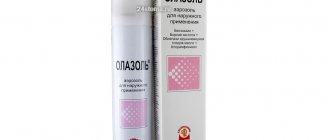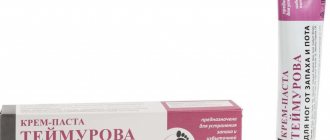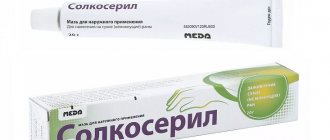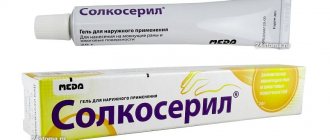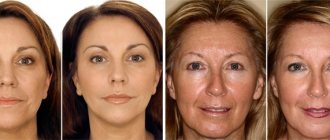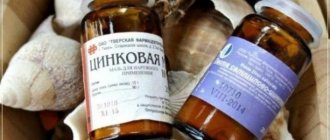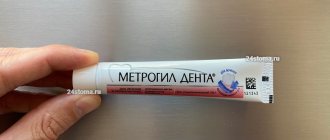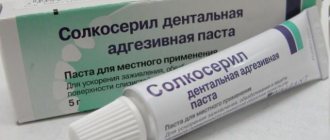From this article you will learn:
- indications for use,
- instructions for use in the oral cavity,
- composition analysis, analogues, price 2022.
The article was written by a dentist with more than 19 years of experience.
Solcoseryl dental adhesive paste is a dental preparation based on deproteinized dialysate from the blood of calves, which is intended to accelerate the healing of ulcers, erosions and traumatic injuries of the oral mucosa. The drug can only be used on moist mucous membranes and, accordingly, it is not suitable for the treatment of wounds and skin lesions. In the latter cases, you should use Solcoseryl forms - in the form of a gel or ointment.
The drug is produced by an international pharmaceutical company and is registered as a “medicinal product”. In addition, it has no age restrictions and is available without a prescription. Solcoseryl dental paste has the appearance of a pale yellow homogeneous granular mass. If you squeeze the paste out of the tube, you will notice that it has a slightly dry consistency. Despite this, the paste is easily distributed and firmly fixed on the oral mucosa, while also performing the function of a protective bandage. The latter is very important, because if there are erosions on the mucous membrane, eating will be very painful.
Solcoseryl dental paste: photo of packaging
Indications for use –
- for stomatitis – to accelerate the healing of ulcers and relieve pain (Fig. 3),
- after surgical operations in the oral cavity,
- bedsores under dentures
- for the treatment of jamming in the corners of the mouth,
- to accelerate the healing of the socket of an extracted tooth with alveolitis (Fig. 4).
This article was written by a dental surgeon, and in some cases that require clarification, the optimal solution for these indications will still be not adhesive dental paste, but Solcoseryl in gel form. In our opinion, for stomatitis, the paste will be optimal only in the presence of deep ulcerations, and for superficial erosions it will be better to use a gel. The same applies to the treatment of bedsores under dentures. For a detailed description of the use of the drug, read below.
Solcoseryl dental paste – price, composition and analogues
The cost of this drug has increased significantly by the end of 2022 and, frankly, the increase is completely inadequate. As a practicing doctor, I don’t quite understand how a drug with the simplest composition can be so expensive. For Solcoseryl dental adhesive paste, the price in Russian pharmacies will be on average from 1600 to 2000 rubles, although in neighboring Poland its price is only 800 rubles (prices are indicated for October 2022).
Composition of the drug: (the paste is available in aluminum tubes of only 5 g).
| 1 g of paste contains - → deproteinized dialysate from the blood of healthy dairy calves, → polidocanol 600. | 2.125 mg 10 mg |
| Excipients - carboxymethylcellulose, peppermint oil, menthol, gelatin, pectin, liquid paraffin, polyethylene 350000, preservatives - methyl parahydroxybenzoate (E218) and propyl parahydroxybenzoate (E216), as well as a residual amount of parahydroxybenzoic acid (E 210). |
Solcoseryl dental paste: official instructions ()
Composition analysis - the main component of the drug Solcoseryl Denta is deproteinized (devoid of proteins) dialysate from the blood of dairy calves. The dialysate contains a large number of low molecular weight organic compounds - amino acids, oligopeptides and glycolipids, nucleosides, etc., which significantly accelerate the healing processes of damaged tissues. Polidocanol-600 has an analgesic effect, which is felt within 2-3 minutes after applying the paste and lasts about 3-5 hours).
Paying attention to the auxiliary components, it must be said that carboxymethylcellulose, gelatin, pectin, liquid paraffin and polyethylene are the basis of the paste, and these components allow it to adhere well to the moist mucous membrane of the oral cavity and not be washed off with saliva. People with allergies to parabens (a certain type of preservative) should pay attention to the small content of parahydroxybenzoic acid.
Cheaper analogues -
Today, Solcoseryl dental adhesive paste has no direct analogues. There are drugs with a similar effect, but a completely different composition. For example, to accelerate the regeneration of the oral mucosa, gum gels containing hyaluronic acid are suitable for you:
- Curasept “ADS 350 Regenerative” gel is a very interesting oral gel from the Swiss. Due to the content of 0.5% chlorhexidine, the gel has an antiseptic effect, and thanks to hyaluronic acid, it has a wound healing effect. This gel also contains the PVP-VA complex, which forms a protective film on wound surfaces and ulcers, accelerating their healing. The price for Curasept ADS 350 Regenerative will be about 650 rubles (for a 30 ml tube), but be careful when purchasing, because in the Curasept line there is a gel with a similar name and without hyaluronic acid.
- Oral gel "GengiGel" (GengiGel) is a gel for the mucous membrane of the gums and oral cavity, which contains 0.2% hyaluronic acid, as well as xylitol. We have already said above that hyaluronic acid has a wound-healing effect. Unfortunately, this drug costs much more than the previous one, and its concentration of hyaluronic acid is much lower.
Solcoseryl gel: instructions and application diagram
For Solcoseryl-gel, the instructions for use contain information that the drug has the following types of pharmacological effects when applied to the skin or mucous membrane of the oral cavity - antihypoxic, cytoprotective, regenerating, membrane stabilizing, angioprotective, wound healing (24stoma.ru). In simple terms, this means that the drug has the following properties -
- increases regenerative processes (accelerating tissue regeneration by approximately 30%),
- stimulates collagen synthesis,
- stimulates cell division (reproduction),
- promotes activation of metabolic processes in cells (increases oxygen consumption by cells, and also stimulates the transport of glucose into cells), which allows damaged cells of the body to recover faster.
The use of the gel on the skin and mucous membrane of the oral cavity has several differences. In this regard, below we will separately consider the features of using the gel on the skin and red border of the lips, as well as in the oral cavity. If you wish, you can look at the application specifics in the official instructions (see the link below), but we describe the application patterns in different situations in this article in much more detail.
Solcoseryl gel: official instructions for use ()
Application for treating skin wounds –
Solcoseryl in gel form is intended only for the treatment of fresh, wet wounds, i.e. wounds that have wet discharge. If your wound is already covered with crusts and does not have a wet discharge, you need to use solcoseryl in the form of an ointment. A very important point is that the gel cannot be applied to wounds with purulent discharge (in this case, you first need to have the wound surgically treated by a doctor). In addition, if the wound has torn edges, then surgical treatment is also necessary, without which the wound will quickly fester.
The gel can be applied to wet wounds if the discharged liquid is clear or includes a small amount of blood (i.e., it is “ichor”). But even in these cases, before applying the gel, the wound must be treated with an antiseptic - best using a sterile gauze swab generously moistened with 3% hydrogen peroxide. After antiseptic treatment with another sterile gauze swab, you need to remove excess moisture from the wound and apply a thin layer of gel.
This two-stage treatment should be carried out 2-3 times a day until the wound is covered with granulation tissue and begins to dry out. After this, you need to start using Solcoseryl in the form of an ointment, which is intended specifically for dry wounds on the skin.
Application of gel in the oral cavity –
If you have developed shallow erosions/ulcers due to stomatitis or wearing removable dentures, Solcoseryl gel will be an excellent remedy. If you have a deep ulcer, then it is better to use this drug not in the form of a gel, but Solcoseryl in the form of a dental paste, which, in addition to accelerating healing, also has the function of a protective therapeutic dressing.
You can also use the gel in the mouth 2-3 times a day, making sure to rinse your mouth before using this antiseptic solution. The choice of antiseptic will depend on the cause of the disease. For example, for erosions and ulcers due to herpetic stomatitis, you need to rinse your mouth with a solution of Miramistin, which is active against the herpes virus. In all other cases, it is better to use the antiseptic Chlorhexidine. How to use these antiseptics correctly - see the links below.
After rinsing your mouth, you need to dry the mucous membrane at the site where the gel is applied with a clean, dry gauze swab (in this case, the gel will stick better), and then, without rubbing, simply apply the gel using a clean finger. If we are talking about treating bedsores under prostheses, then immediately after applying the gel you need to put on the prosthesis.
→ Regimen for the use of Chlorhexidine → Regimen for the use of Miramistin
Important: it is advisable to treat the mucous membrane with gel immediately after eating and subsequent oral hygiene. In the absence of good hygiene, a bacterial infection can join wounds and ulcers on the oral mucosa, causing inflammation. After brushing your teeth, you can rinse your mouth with an antiseptic and apply the gel. Next, it is advisable not to eat or rinse your mouth for 2-3 hours; you can drink.
Solcoseryl dental adhesive paste - instructions for use
For Solcoseryl dental adhesive paste, the instructions for use contain information that the paste can be used 3-5 times a day. The effective analgesic effect of the paste develops not only due to the content of polidocanol-600, but also because the paste applied to the surface of an ulcer or wound surface forms a protective therapeutic dressing that protects the damaged oral mucosa from the effects of mechanical, chemical and thermal irritants.
Solcoseryl dental paste should be applied directly to the wound surface in a thin layer (without rubbing). This can be done either with a medical spatula or with a regular finger. Before applying the paste, it is very important to first dry the mucous membrane at the application site using a dry gauze swab. After blotting the mucous membrane with a swab, squeeze the paste onto your index finger and apply it to the damaged area of the mucous membrane (24stoma.ru).
It is most convenient to do this with your finger, because... in this case, you will distribute the paste faster and better over the surface of the mucous membrane. You can also use a cotton swab, but in this case it will be a little worse to form a tight protective bandage. After applying the paste, it is necessary to moisten it with saliva, which will allow the paste to swell and finally adhere to the mucous membrane.
The length of time the medicinal paste bandage remains on the mucous membrane may vary. For example, on a low-moving mucous membrane, the bandage will last longer, and on highly mobile areas of the mucous membrane, the fixation will always be somewhat worse, which, in principle, then allows us to consider replacing the adhesive paste with Solcoseryl gel form.
Brief application diagram –
- eating,
- teeth cleaning,
- rinsing your mouth with an antiseptic,
- apply Solcoseryl paste,
- Do not eat or rinse your mouth for 2-3 hours (you can drink).
Features of use for stomatitis, alveolitis -
Solcoseryl adhesive paste should not be used in the acute period of inflammation, because There are no antiseptics or antibiotics among the paste components. Therefore, if we are talking about infectious processes in the oral cavity, the use of paste is possible only after the acute period of inflammation has subsided, and only after that can the use of agents that accelerate healing be started.
1) Erosion and ulcers due to stomatitis - before applying the paste, it is advisable to always treat the oral mucosa with an antiseptic. For herpetic stomatitis, it is best to use a miramistin solution, and for aphthous stomatitis or damage to the mucous membrane after tooth extraction/surgery, use a chlorhexidine solution. In this case, miramistin can be used in a spray format, and chlorhexidine should be used to rinse the mouth for 1 minute.
It is advisable to use the antiseptic 2-3 times a day. You can read the features of using these antiseptic solutions in the oral cavity using the links below. Once again, we would like to draw your attention to the fact that Miramistin will be the best choice only for infectious processes of viral origin; in all other cases, it is better to use chlorhexidine.
→ regimen for the use of Chlorhexidine, → regimen for the use of Miramistin.
2) Application for alveolitis - solcoseryl in the form of dental paste is an excellent remedy for the treatment of alveolitis in the socket of an extracted tooth. The use of the paste is again indicated not in the acute period of inflammation, but only after the acute symptoms have subsided. At the first stage of treatment, removal of a necrotic blood clot from the hole is indicated (which only a dentist can do) - filling the hole, for example, with iodoform turunda.
But after the inflammation subsides, it is already possible to add adhesive paste into the hole. It is difficult to do this at home, because... in the depths of the hole that is not filled with a blood clot, food debris and bacteria are always present. And before adding the paste, you first need to rinse the well with a stream of antiseptic (for example, chlorhexidine) from a syringe, then dry it inside with a dry gauze swab to remove excess liquid, and only then fill it to the top with paste.
Applying the paste into the hole quickly relieves pain, and after about 5 minutes relief comes. But if you apply the paste into an inflamed hole, or in the depths of which there are food remains, this can provoke the development of inflammation and lead to suppuration.
3) Bedsores under dentures – one of the indications for use of Solcoseryl in the form of dental paste is bedsores under dentures. The latter can occur, for example, when you have made a new removable denture or under old dentures, when they no longer correspond to the tissues of the prosthetic bed. In the latter case, the prosthesis needs to be changed, and Solcoseryl will not be able to help you with anything, because The problem here is the old prosthesis.
But during the period of adaptation to a new prosthesis, Solcoseryl can actually be used to accelerate the epithelization of damaged mucosa and relieve pain. However, this does not mean that you should not contact your prosthetist for removable denture adjustments. Usually 2-3 corrections are required before the new prosthesis stops rubbing the mucous membrane. And, by the way, for bedsores under a prosthesis, it is better to use not adhesive paste, but Solcoseryl in gel form.
Prevention of oral diseases
The best option is to visit the dentist at least twice a year. This way you will save your health and finances. Be sure to have your mouth professionally cleaned, this will help to efficiently remove all accumulated plaque and hard deposits. The following procedures are recommended for gum health:
- Massage your gums at home, this can be done with your fingers or a soft toothbrush.
- Beware of hot foods to avoid burns.
- Be sure to wash your hands several times a day, especially after going outside, to reduce the risk of stomatitis.
- Use mouthwash.
- We advise you to purchase an irrigator; this device significantly improves blood circulation in soft tissues.
Solcoseryl dental adhesive paste: reviews
Solcoseryl paste will have a pronounced effect and accelerate the healing of wounds, erosions and ulcers, provided that they are not related to tumor-like lesions. The benefits of the drug are undeniable if you use it in accordance with these instructions. The form of Solcoseryl in the form of a dental adhesive paste is especially convenient if you need the drug to also act as a protective medical dressing (for example, after surgical interventions).
In many other cases (for stomatitis, for the treatment of bedsores under dentures), it is actually more convenient to use Solcoseryl not in the form of a paste, but in the form of a gel. The latter is also cheaper, and the volume of the tube is 4 times larger. But the paste is most convenient for the treatment of alveolitis (to accelerate the epithelization of the “empty socket” and relieve pain), use after surgical operations in the oral cavity, and especially for the treatment of deep ulcers.
Once again, we draw your attention to the fact that long-term non-healing ulcers can be a symptom of tumor growth. And if you have a history of such an ulcer or if there is no effect from using Solcoseryl, you should definitely consult a dental surgeon for advice.
Deproteinized dialysate from calf blood - indications for use
The following list of indications for use is determined by the presence in the drug of deproteinized dialysate obtained from the blood of dairy calves. The dialysate contains a large number of active substances and growth factors that accelerate regeneration processes in the skin and mucous membrane. Indications for use of Solcoseryl gel –
- wet wounds on the skin and red border of the lips,
- trophic ulcers on the skin,
- erosions and ulcers of the oral mucosa,
- bedsores under removable dentures,
- injuries to the mucous membrane from removable and fixed dentures, sharp edges of fillings.
Once again, we draw your attention to the fact that when using the drug on the skin and red border of the lips, the indication for use is only wet wounds. Those. wounds must not be covered with crusts and have a moist discharge. If the wound is covered with dry crusts and there is no wet discharge, then according to the instructions for use, it is necessary to use not a gel, but Solcoseryl in the form of an ointment.
If you plan to treat the oral mucosa, then keep in mind that the gel form is optimal for superficial lesions of the mucous membrane - shallow ulcers, burns, bedsores under dentures. But if the ulcer is deep enough, or you need to cure alveolitis in the hole of an extracted tooth, then in this case it is better to use another form of this drug - Solcoseryl dental paste.
Contraindications –
The only contraindication is hypersensitivity to one of the components of the drug. Solcoseryl "Denta" is not contraindicated during pregnancy and breastfeeding. It should be used with caution only if you have severe allergic reactions. The drug contains a residual amount of parahydroxybenzoic acid (E 210), which is important to take into account in patients with allergic reactions to this component.
Allergic reactions usually develop in the form of slight swelling at the site of application of the drug. In this case, you must stop using the drug and also take an antihistamine tablet. Also, an allergic reaction may be indicated by a burning sensation at the site of application of the drug. Moreover, a slight burning sensation (which goes away almost immediately after application) does not require discontinuation of the drug. The latter is necessary only if the burning sensation is permanent.
Contraindications and side effects –
The only contraindication to the use of the drug is the presence of hypersensitivity to one of its components. The drug has a high safety profile and has no age-related contraindications, and is also approved for use in pregnant and lactating women. The only point you need to pay attention to is that the drug should be used with caution if you are predisposed to allergic reactions.
When used on the skin, Solcoseryl gel can cause local allergic reactions such as urticaria or marginal dermatitis. If the drug is used on the oral mucosa, usually one of the signs of an allergy will be limited swelling of the soft tissue at the site of application. Another sign of an allergy may be a prolonged, continuous burning sensation at the site of application, which requires discontinuation of the drug. If the burning sensation is short-term, then this is acceptable and does not require discontinuation of the drug.
Special instructions -
- The drug is safe for use in children, including infants.
- Solcoseryl dental adhesive paste cannot be applied to an infected wound, because it does not contain antimicrobial components.
- Before applying the paste, always treat the application area with an antiseptic.
- If fever appears, as well as redness, pain and swelling in the area of the mucous membrane near the site of application of Solcoseryl, or if discharge appears from the wound, you should consult a doctor.
- If, when using the drug, the ulcer does not heal within 10 days, you should also consult a doctor, because this may indicate oncology. We hope that our article on the topic: Solcoseryl dental adhesive paste instructions - turned out to be useful to you!
Sources:
1. Dental education of the author of the article, 2. Personal experience as a maxillofacial surgeon, dental surgeon, 3. Official website of the manufacturer – https://solcolife.ru/, 4. “Outpatient surgical dentistry” (Bezrukov V.), 5 . "Therapeutic dentistry. Textbook" (Borovsky E.).
Gel Solcoseryl: reviews
An important condition for achieving a good treatment result is the correct choice of the form of the drug Solcoseryl - this can be in the form of a gel, ointment or dental adhesive paste.
The effect of the gel will be noticeable specifically on wet wounds, and consists in accelerating the formation of granulation tissue by about 30%. You will not notice the effect of the gel when used on dry wounds, and it is unlikely that you will be able to leave a good review of the product after this. Solcoseryl gel will have a good pronounced effect and will accelerate the healing of wounds and ulcer erosions, unless, of course, they are related to tumor-like lesions. The latter must be especially borne in mind, because if the erosion or ulcer has existed for a long time, or there is no effect when using Solcoseryl, then these are signals indicating that this lesion of the mucous membrane/skin is related to tumor-like tissue damage.
Another important point is applying the drug to infected wounds. For the drug to give a good result, there must be no infection in the wound. Purulent wounds, as well as wounds with torn edges, first require primary surgical treatment and drug therapy. Reviews for Solcoseryl gel will be positive only if you carefully follow all recommendations for its use. Failure to follow the recommendations for use, especially with regard to infected wounds, can, on the contrary, lead to increased inflammation.
Solcoseryl anti-wrinkle gel in cosmetology: reviews
Some patients persistently try to use Solcoseryl gel for the face to get rid of wrinkles. The logic here is clear - since the drug increases proliferation (reproduction) and activity of fibroblasts, then its use should seem to lead to an increase in collagen production. Unfortunately for patients, it must be noted that none of the forms of solcoseryl work on intact skin.
Therefore, Solcoseryl ointment or gel is not used in cosmetology, and they are effective only for accelerating the healing of skin damage, including after surgical and cosmetic interventions. To stimulate collagen production in aging skin, it is better to use retinoid-based products, and an even faster effect is achieved by a hardware technique that uses fractional lasers. These techniques do have proven evidence of increasing collagen in the skin (see links above for arguments and clinical studies).
If you are interested in a cream that can improve skin regeneration and keep it moisturized, especially in winter, one of the best options would be to use Bepanthen for Dry Skin cream. It contains not only dexpanthenol (a precursor to vitamin B5, which enhances skin regeneration), but also moisturizing components such as the emollient “lanolin”, as well as D, L-pantolactone. I recommend this product because... I myself use it 2 times a day in the winter and see its effectiveness from personal experience. It can even be applied to the moving parts of the eyelids. A 100 ml tube costs only about 950 rubles.
